Cuprins
- 1 The best birdwatching areas in Romania
- 2 Essential bird identification techniques
- 3 Birding techniques for beginners – How to start bird watching
- 4 Equipment needed for birdwatching
- 5 Common backyard birds: your garden watchlist
- 6 What time of year is best for birding?
- 7 What time are birds most active?
- 8 Frequently asked questions (FAQ) about birdwatching in Romania
- 8.1 What are the best bird field guides or apps for identifying birds in Romania?
- 8.2 Are there ethical rules for birdwatching?
- 8.3 How can I connect with bird watching organizations or contribute my sightings?
- 8.4 What should I do if I find an injured bird?
- 8.5 How can I make my own garden a better spot for birds?
Birdwatching is a recreational activity that involves identifying and studying birds in their natural habitat. It can be a simple walk in the park or a dedicated expedition to a special area. The beauty is in the simplicity: you don’t need complicated equipment to get started, just curiosity and a desire to connect with nature. With each species you identify, each new song you recognize, you discover a fascinating, often overlooked world.
In recent years, birdwatching has gained popularity, especially in areas like the Danube Delta. This is due to the Delta’s unique biodiversity, which attracts birdwatchers and nature enthusiasts from all over the world. The delta offers an impressive avifauna show with hundreds of bird species, some of them extremely rare and protected. Seeing these magnificent creatures in their natural environment is an unforgettable experience that brings you closer to nature and makes you appreciate the importance of conserving natural habitats.
The best birdwatching areas in Romania
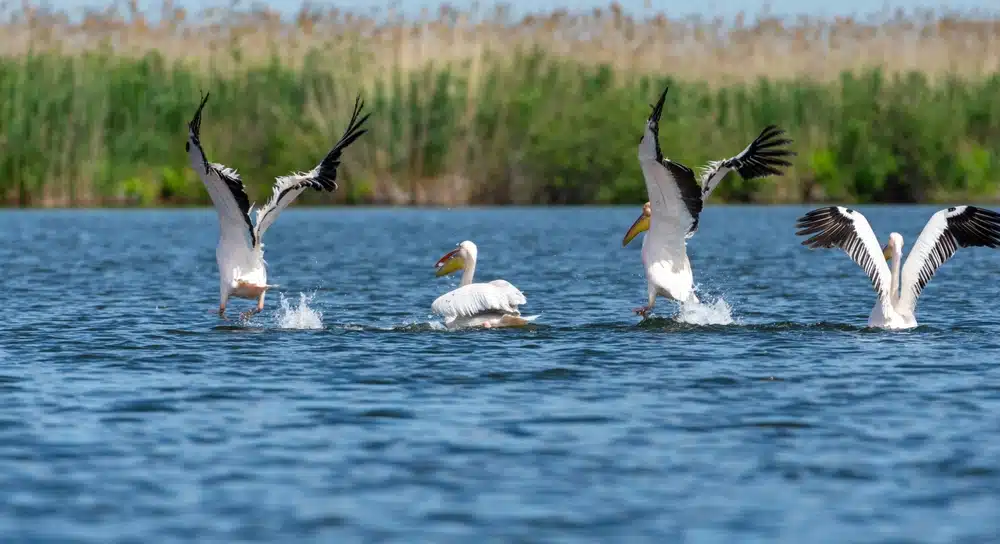
Pelicans, Danube Delta
Romania is a birdwatcher’s paradise, offering an astonishing variety of landscapes and habitats, each with its own unique charm and species.
Danube Delta
The Danube Delta is the largest wetland ecosystem in Europe and a paradise for birdwatchers. A UNESCO World Heritage Site, the region stands out for its exceptional biodiversity and the key role it plays in bird migration.
👉 Want to experience birdwatching right in the heart of the Danube Delta? Choose an accommodation close to nature, where tranquility and birds are at home. Discover the accommodation options at Dolphin Camping and get ready for an unforgettable experience!
With more than 300 species observed, the Delta offers a rare chance to see spectacular birds such as the Dalmatian pelican, common pelican, little cormorant, night, yellow or reddish herons, egrets, egrets, wagtails, glossy ibis or red-tailed godwits. Landscapes range from narrow canals and quiet lakes to dense reedbeds, sandy screes and wet woodlands – each habitat attracting different types of birds.
Each season has its own charms: spring and autumn bring spectacular waves of migratory birds, summer is ideal for spotting nesting species, while winter offers special sights of waterbirds from the north of the continent.
A boat trip, accompanied by a local guide, gives you the best conditions for observation and photography.
Continue this fascinating dive into birdwatching in the Danube Delta area by getting to know a little bit more about three iconic birds of the Danube Delta.
The Great White Pelican (Pelicanul Comun – Pelecanus onocrotalus)
The undisputed symbol of the Danube Delta, the Great White Pelican is an immense and majestic bird that forms Europe’s largest colonies right here. More than 50% of the entire continent’s Great White Pelican population breeds in the Delta.
- How to Identify: It’s hard to miss. This is a huge, predominantly white bird with black flight feathers that are visible only when it opens its wings. It has a massive, pale-yellow gular pouch under its long bill and short, fleshy-yellow legs. Males are larger than females. In flight, they are surprisingly elegant, often seen soaring in V-formations.
- Behavior and Where to Find Them: Pelicans are social birds, living and fishing in large colonies. They are famous for their cooperative fishing technique, where groups of 6-8 birds form a horseshoe to herd fish into the shallows, then scoop them up with their pouches. Look for them on large, open lakes like Furtuna or Roșu, and in the nesting colonies in protected areas like Roșca-Buhaiova, which is the largest pelican colony in Europe.
👉 If you come to the Danube Delta, don’t stop at just one activity. Discover other authentic experiences that perfectly complement your Delta exploration!
The Pygmy Cormorant (Cormoranul Mic – Microcarbo pygmaeus)
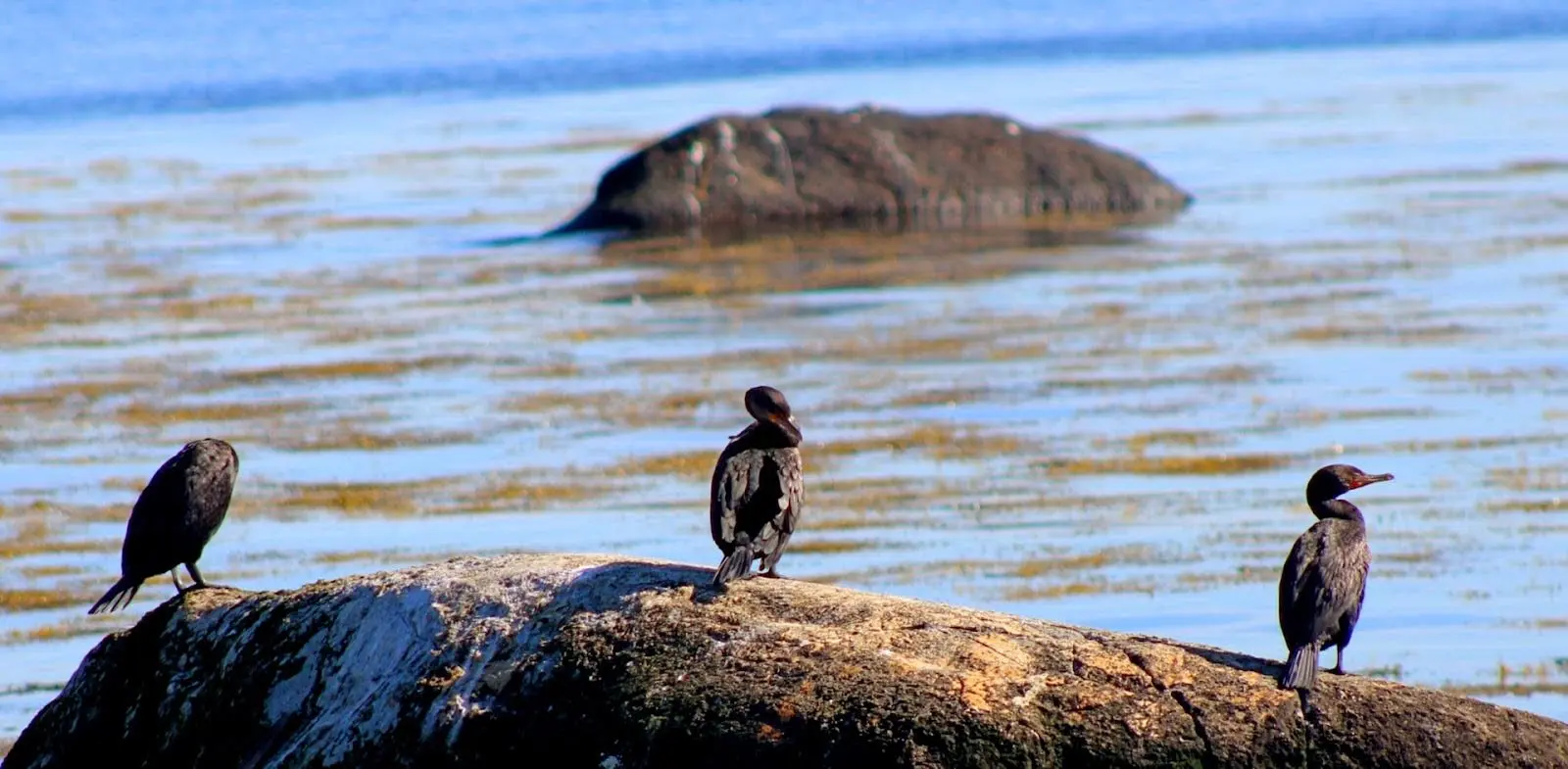
Three pygmy cormorants sitting on a rock in the water
While its larger cousin, the Great Cormorant, is widespread, the Pygmy Cormorant is a regional specialty. The Danube Delta hosts the world’s biggest breeding colony, making it a prime location to spot this globally threatened species.
- How to Identify: This bird is distinguished by its size—it’s much smaller and more slender than a Great Cormorant, with a noticeably long tail and a shorter, thicker bill. Its plumage is a glossy black with a green sheen, and during breeding season, adults have fine white feather tufts on their head and neck.
- Behavior and Where to Find Them: Pygmy Cormorants prefer wetlands with dense vegetation. You can see them perching in groups on willow trees or dead branches overhanging the narrow canals. They are agile swimmers and often hunt for fish in small groups. A boat trip through the quieter channels and lakes is the best way to observe them.
The Little Egret (Egreta Mică – Egretta garzetta)
A vision of elegance, the Little Egret is a delicate white heron that adds a touch of grace to the Delta’s waterways.
- How to Identify: The Little Egret is a slender, medium-sized bird with pure white plumage. Its most distinctive features are its slender, dagger-like black bill and long black legs, which contrast sharply with its bright yellow feet. These “golden slippers” are especially visible in flight or when the bird is wading in shallow water.
- Behavior and Where to Find Them: Little Egrets are active hunters. They stalk their prey in shallow waters along the edges of lakes and canals. You might see them shuffling their yellow feet in the water to disturb small fish and amphibians, which they then catch with a swift jab of their bill. They are common throughout the Delta and can often be seen foraging alone or in small, scattered groups.
Carpathian Mountains
For mountain lovers, the Carpathian Mountains offer spectacular bird-watching, with some of the best preserved ecosystems in Central Europe. Here, coniferous and deciduous forests, cliffs and alpine hollows are home to an impressive avifauna.
Regions such as Piatra Craiului, Retezat, Bucegi and the Rodnei Mountains are recognized not only for the beauty of their landscape, but also for the rare species that can be found. Among them are the mountain eagle, the capercaillie, the great owl, the black woodpecker and the raven – real treasures for birdwatchers.
The Carpathian Mountains are the ideal place to combine birdwatching with hiking. The mountain huts and well-marked trails give you the chance to explore remote areas where the chances of spotting birds in their natural habitat increase considerably.
Whether you follow a ridge trail or venture into the dense forests, you’ll discover not only species hard to find in other regions, but also the tranquillity of a wild, authentic landscape. A hike in these mountains is undoubtedly a bonus for anyone seeking a deep connection with nature.
The Golden Eagle (Acvila de Munte – Aquila chrysaetos)
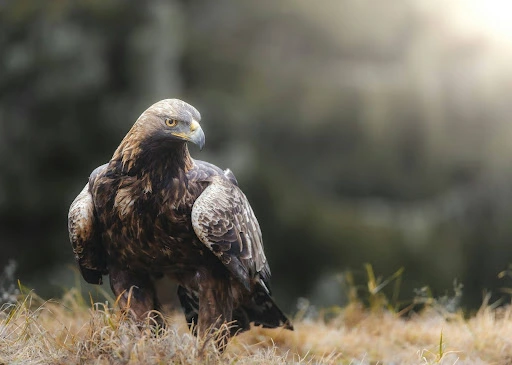
The Golden Eagle (Acvila de Munte - Aquila chrysaetos)
The “mountain eagle” itself, the Golden Eagle is the king of the Carpathian skies. Spotting this magnificent raptor soaring over high peaks is a truly unforgettable experience and a highlight for any hiker or birdwatcher. They are a symbol of wild, untouched nature.
- How to Identify: This is a very large bird of prey, with a wingspan that can exceed 2 metres. Adults are uniformly dark brown, with a distinctive golden-brown wash over the crown and nape (back of the neck), which gives the bird its name. They have a powerful, hooked bill and fully feathered legs right down to their talons.
- Behavior and Where to Find Them: Golden Eagles prefer open, high-altitude terrain for hunting, using rocky cliffs and crags for nesting. To see one, you need to look up. Scan the ridges and mountain peaks in national parks like Piatra Craiului and Retezat. They often soar effortlessly on thermal updrafts, sometimes for hours. A pair of good binoculars is essential to appreciate them from the trails below.
The Western Capercaillie (Cocoșul de Munte – Tetrao urogallus)
A grand and elusive prize for the dedicated birdwatcher, the Capercaillie is the world’s largest grouse species. It lives a secretive life in the quiet, old-growth forests of the Carpathians, making any sighting a special event.
- How to Identify: The male (cock) is unmistakable: turkey-sized, with a dark grey to black body, a metallic green sheen on its breast, a bright red “eyebrow” (wattle), and a large tail that it fans out during courtship displays. The female is smaller and her mottled brown-and-black plumage provides excellent camouflage.
- Behavior and Where to Find Them: Capercaillies are ground-dwelling birds that inhabit mature coniferous forests with dense undergrowth for cover and nearby clearings. They are shy and very sensitive to human disturbance. Your best chance to see one is to hike quietly at dawn through the ancient spruce forests of the Rodnei Mountains or the northern parts of the Eastern Carpathians.
The Black Woodpecker (Ciocănitoarea Neagră – Dryocopus martius)
The largest woodpecker in Europe, the Black Woodpecker is a powerful and striking resident of the Carpathian forests. While you may not always see it, its presence is often given away by its loud calls or the evidence it leaves behind.
- How to Identify: This is a large, crow-sized woodpecker covered in entirely black plumage. The only splash of colour is a crimson-red patch on its crown—covering the whole crown on the male, but just the back of the crown on the female. It has a formidable, pale, dagger-like bill.
- Behavior and Where to Find Them: Look for this bird in mature deciduous and mixed forests, like those found in the Bucegi mountains. Listen for its loud, ringing “klee-klee-klee” call or a powerful, rapid drumming that sounds like a short drumroll. You can also spot its work: large, rectangular holes chiselled into tree trunks in its search for insects. Following these sounds and signs is the best way to track one down during a forest hike.
Dobrogea
Dobrogea is one of Romania’s most fascinating regions, both geologically – it’s the oldest part of the country – and for its unusual landscapes. Here you’ll find a rare combination of steppe, limestone cliffs, expansive lakes and xerophytic forests, all concentrated in a compact and easily accessible area.
Some of the most attractive areas for birdwatching are Capul Doloșman, Cheile Dobrogei, Razim Lake and the surroundings of Jurilovca. These places offer an impressive scenery, especially during the migration season, when the number and variety of species increases spectacularly.
Dobrogea is home to birds that love open areas and a warm climate: the stone-curlew, the European nightjar, the Bărăgan lark and the great skylark are just some of the species that can be seen here. The months of May-June and September-October are the best times to visit, due to the intense activity during migration.
Dry landscapes, clear light and intense colors make this region an ideal place for nature photography. Dobrogea is like no other part of Romania – the air, the silence and even the wind seem to contribute to the special atmosphere you’ll feel as soon as you step here.
👉 If you come to Dobrogea for birdwatching, don’t miss the opportunity to explore other treasures in the area. From ancient fortresses and isolated monasteries to spectacular natural landscapes, Tulcea has a lot to offer. Discover the top unmissable tourist experiences in Tulcea and complete your adventure with some memorable stops.
The Pied Wheatear (Pietrarul Negru – Oenanthe pleschanka)
A characteristic bird of Dobrogea’s rocky and arid landscapes, the Pied Wheatear is a striking long-distance migrant that breeds here. Its contrasting black-and-white plumage makes it a favourite subject for photographers exploring the region.
- How to Identify: The male in breeding plumage is unmistakable: a pure white crown and belly contrast sharply with a black back, wings, and face. The female is much plainer, with sandy-brown plumage, but both sexes share the wheatear family’s signature white rump and black T-shape on the tail, which is very visible in flight.
- Behavior and Where to Find Them: Look for this bird in open, rocky areas with sparse vegetation. They often perch on prominent rocks, fences, or limestone cliffs, making them relatively easy to spot. The gorges of Cheile Dobrogei and the rocky slopes around Capul Doloșman are classic locations to find them during the breeding season from May to August.
The European Roller (Dumbrăveanca – Coracias garrulus)
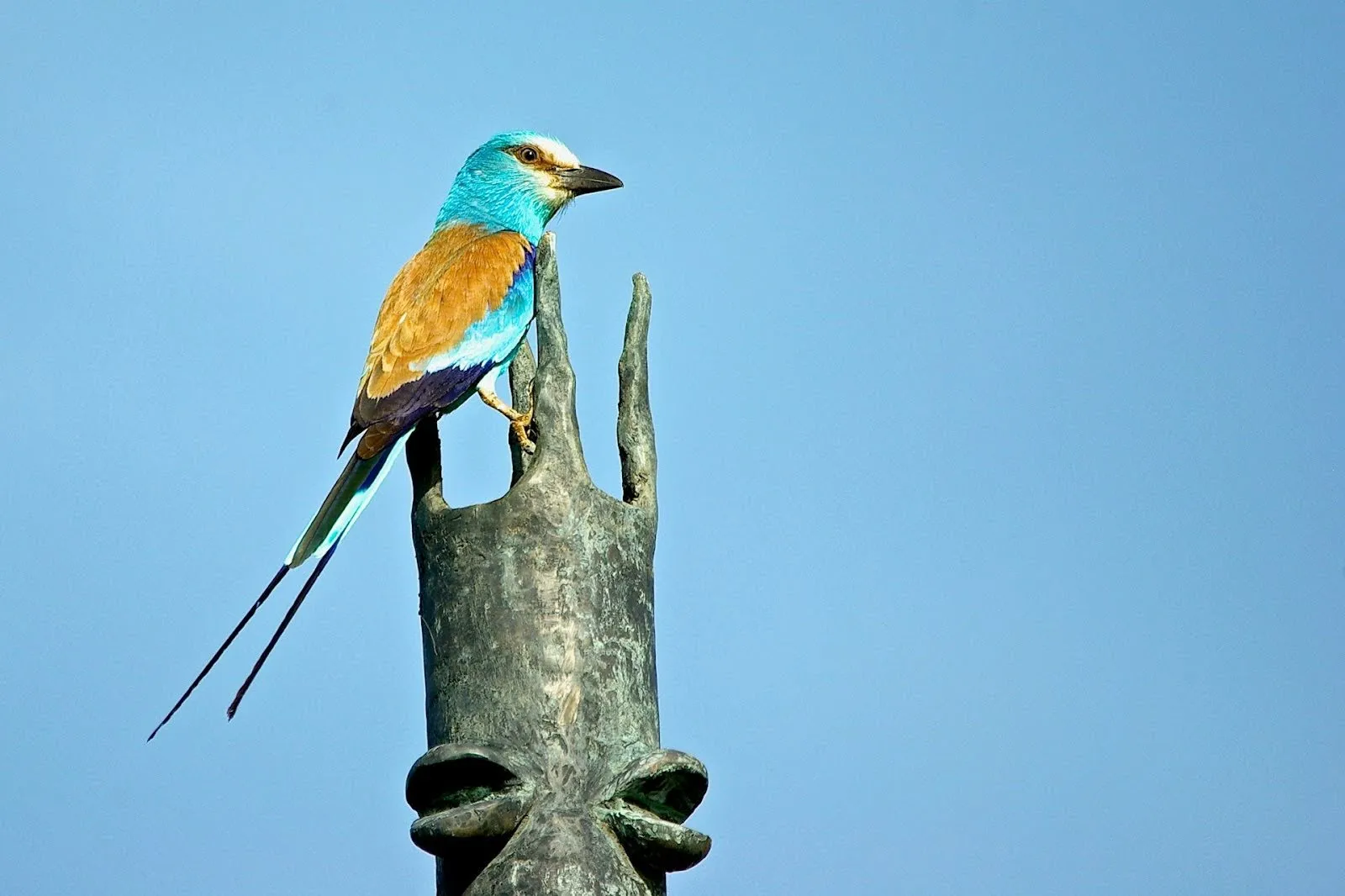
Blue and brown European Roller on a tree branch
Arguably the most exotic-looking bird in Romania, the European Roller is a flash of tropical colour in the Dobrogean steppe. Its vibrant plumage makes it a top target for any birdwatcher visiting during the summer months.
- How to Identify: This bird is the size of a jackdaw, with a chunky build. Its appearance is breathtaking: a brilliant turquoise-blue head and belly, a warm chestnut-brown back, and striking bright blue and black wings that are stunning in flight.
- Behavior and Where to Find Them: Rollers are often seen perching conspicuously on utility wires, dead trees, or fence posts as they scan the ground for large insects. They nest in natural holes in cliffs or riverbanks. Driving slowly through the open landscapes around Jurilovca or in northern Dobrogea offers great chances to see them. Their spectacular rolling and diving courtship flight is how they got their name.
The Calandra Lark (Ciocârlia de Bărăgan – Melanocorypha calandra)
The Calandra Lark is the true voice of the Romanian steppe. A large, robust lark, it is renowned for its rich and complex song, which it delivers while performing impressive display flights high above the open fields.
- How to Identify: This is a stocky lark, much larger and heavier than the common Skylark. Its key field mark is a distinct, large black patch on each side of its neck, which almost forms a collar. It has a streaky brown back for camouflage and a pale belly. In flight, it shows a dark underwing with a contrasting white trailing edge.
- Behavior and Where to Find Them: This bird is a classic inhabitant of open agricultural land and steppe. To find it, drive through the vast farmlands of Dobrogea and listen for its beautiful, melodious song, which famously mimics the songs of many other birds. The best time to experience its concert is on a clear morning from April to June.
Transylvania
Transylvania offers a unique setting for birdwatching, where well-preserved nature blends harmoniously with history and traditional architecture. The hilly and mountainous landscapes, with deep forests and ancient villages, create a special atmosphere, perfect for quiet and authentic birdwatching.
Areas such as the Apuseni Mountains, the Szeklerland and the Făgăraș Depression are characterized by the diversity of habitats and the presence of species that are harder to find in other regions. Here you can see spectacular birds such as the three-toed woodpecker, black woodpecker and red-breasted flycatcher.
One of Transylvania’s great assets is the low level of mass tourism in many of its wilderness areas. This means less crowding and better chances to see birds in their natural behavior without major human interference.
This region is ideal for those who want to combine eco and cultural tourism. Imagine a morning spent in the forest watching a rare woodpecker, followed by an afternoon exploring a Gothic castle or a Saxon village. Transylvania offers exactly that kind of experience – balanced, deep and memorable.
The Ural Owl (Huhurezul Mare – Strix uralensis)

An Ural Owl sitting on a branch in front of a mountain cabin
A powerful and elusive predator of the deep forests, the Ural Owl is one of Transylvania’s great secrets. It is slightly smaller than the Eagle-Owl and is a prize sighting for any birdwatcher exploring the region’s vast, old-growth forests.
- How to Identify: This is a large, pale owl with a round head and no ear tufts. Its plumage is a soft grey-brown, heavily streaked with dark brown. It has a distinct pale facial disc with dark, piercing eyes and a strong yellow bill. Its long tail is a key feature, often visible when it’s perched.
- Behavior and Where to Find Them: The Ural Owl is primarily nocturnal but can sometimes be seen hunting at dawn or dusk. It prefers extensive, mature deciduous and mixed forests, often near small clearings. The ancient forests of Szeklerland (Ținutul Secuiesc) and the Apuseni Mountains are key habitats. Listen for its deep, booming call—a “hoo-hoo… hu-hooooo”—on quiet evenings.
The Three-toed Woodpecker (Ciocănitoarea de Munte – Picoides tridactylus)
A true specialist of mountain forests, the Three-toed Woodpecker is a reliable indicator of a healthy, natural ecosystem. Unlike other woodpeckers, it has only three toes, an adaptation for climbing and foraging on coniferous trees.
- How to Identify: This is a medium-sized woodpecker with a striking “zebra-striped” pattern on its back. It has a white face with black stripes, and its belly is barred with black. The male has a bright, lemon-yellow crown, which the female lacks. Look for its unique three-toed feet if you get a very close view.
- Behavior and Where to Find Them: This species is almost exclusively found in mature spruce forests. It feeds on bark beetles and is often found on dead or dying trees. It is a quiet and unobtrusive forager. To find it, hike through the high-altitude coniferous forests in the Apuseni or Făgăraș Mountains and look for trees where the bark has been systematically scaled off in patches.
The Red-breasted Flycatcher (Muscarul Mic – Ficedula parva)
A tiny, energetic bird, the Red-breasted Flycatcher is a delightful summer visitor to Transylvania’s cool, shady forests. It is the smallest of the European flycatchers, and finding one is a reward for a quiet, patient walk in the woods.
- How to Identify: This is a small, slim bird. The male is the most distinctive, with a bright orange-red throat and upper breast that contrasts with its grey head and brown back. Females and juveniles are much plainer, lacking the red throat, but all share a key feature: a tail pattern with white patches at the base, which they frequently flick upwards.
- Behavior and Where to Find Them: This flycatcher prefers mature, damp deciduous and mixed forests with a thick canopy. It is often found near streams or in valleys. Listen for its distinctive song—a high-pitched, rattling melody. It is an active bird, often flitting from a perch to catch insects in mid-air before returning to the same spot. The forested valleys of the Apuseni Mountains are a great place to look for it.
Essential bird identification techniques
Identifying birds may seem challenging initially, but it becomes easier with practice and attention to detail. Key features to observe include size, shape, color patterns, and habitat. Begin by noting the bird’s overall size – is it smaller than a sparrow or larger than a robin? Pay close attention to its shape, including the bill, tail, and wing structure. Color patterns are also crucial; note any stripes, spots, or patches of color.
Bird calls and behavior can offer valuable clues for identification. Each species has a unique set of vocalizations, which can be learned through field guides or online resources. Listen for distinct songs, calls, and chips. Observe the bird’s behavior – how does it move, feed, and interact with its environment? Does it hop along the ground or fly from branch to branch? Does it forage for insects or feed on seeds? By combining visual observations with auditory and behavioral cues, you can significantly improve your bird identification skills.
👉 A great way to enhance your identification abilities is by focusing on a bird-rich ecosystem. Discover everything you need to know about birds in the Danube Delta!
Consider the context in which you observe the bird. Is it in a forest, a field, or near water? Different species prefer different habitats. Also, note the time of year, as some birds are only present in certain areas during migration or breeding seasons.
Birding techniques for beginners – How to start bird watching
If you’re new to birdwatching, don’t be discouraged if you don’t immediately recognize all the species. With a little practice and a few simple techniques, you’ll become a skilled birder.
1. Learn to notice the details
Pay attention to the size and shape of the bird’s body, plumage color and pattern, beak and leg shape. These details help you distinguish it from other species. Observe its behavior: how it moves, forages for food, interacts with other birds.
2. Listen carefully
Identifying birds by sound is a valuable skill. Learn to recognize common songs and calls. Note the distinctive characteristics of sounds: pitch, rhythm, duration. You can use apps to compare recordings with sounds you hear in nature.
3. Choose the right place and time
They visit different habitats: forests, wetlands, meadows. Each habitat attracts different species. Go early in the morning or in the evening when birds are most active. Pay attention to seasonality: spring and fall are migration periods when you may see rare species.
4. Choose the right equipment
For a first-time bird watcher, choosing the right beginner-friendly equipment is fundamental to turning initial curiosity into a lasting passion. The quality of your starter tools can be the difference between a frustrating day of missed opportunities and a rewarding experience that makes you eager for the next outing.
Good equipment, designed for ease of use, removes barriers and allows you to connect more directly with the wildlife around you. It helps bring the details of the natural world into clear view, making the challenge of identification an exciting puzzle rather than a struggle. When your tools are intuitive and reliable, you can focus your attention on the birds themselves—their behaviour, colours, and songs.
5. Be as discreet as possible – camouflage and behavior
To observe birds without frightening them, move slowly and quietly. Avoid sudden noises and gestures. You can use the surrounding vegetation as cover – a tree, a bush, a rock – but don’t destroy the environment. Keep your distance from birds, especially during the nesting season when they are very sensitive. Don’t try to get too close or interfere with their behavior. The more invisible you are, the more likely you are to see something really spectacular.
By practicing these techniques, you will develop the skills you need to fully enjoy this fascinating activity. The more time you spend in nature, the better you’ll become at spotting and identifying birds.
👉 Would you like to see pelicans flying a few meters away from you? You can do it on a birdwatching tour in the Danube Delta, with people who know exactly where to look.
Equipment needed for birdwatching
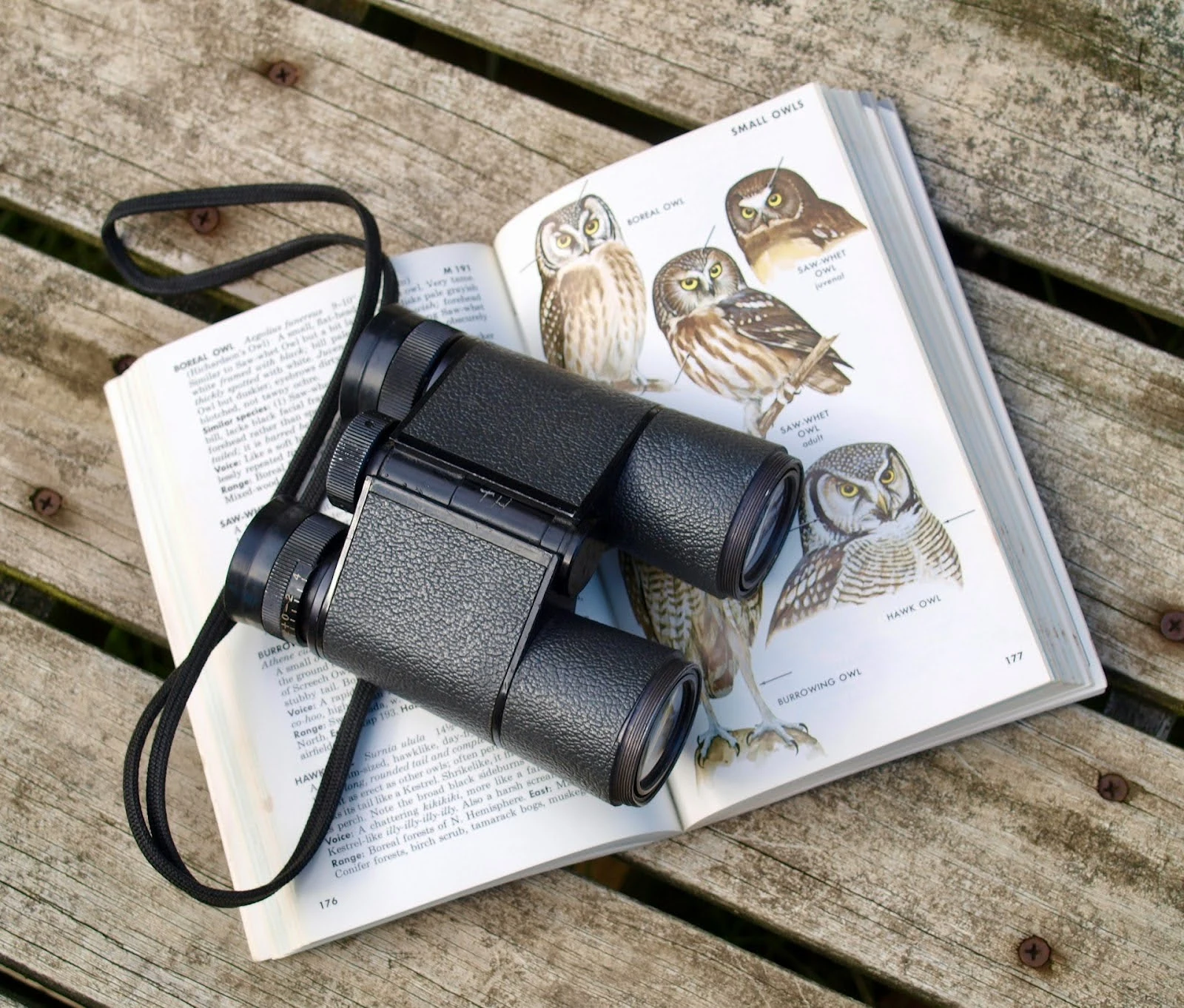
Birdwatching binoculars on an open bird identification guide
To fully enjoy the birding experience, you need a few essentials. Don’t worry, it’s not expensive or complicated equipment.
1. Binoculars
Good binoculars are probably the most important tool. It helps you see birds at a distance without scaring them off. Look for a model with 8x or 10x magnification, which means you’ll see birds 8 or 10 times closer than with the naked eye. The diameter of the lens (usually 42mm) influences how bright the image is, which is especially important in low-light conditions.
2. Bird identification guide
An identification guide makes your job much easier when you want to know which bird you’ve just seen. You can choose a printed version, adapted to the Romanian fauna, or use a mobile app. The most useful guides contain clear photographs, descriptions of how birds behave and where they can be found, maps showing the areas where they live, and details of the specific sounds of each species.
3. Appropriate clothing
Comfort is key. Choose clothes in neutral colors that don’t make you too conspicuous. Waterproof footwear is important, especially if you venture into wet areas. Don’t forget a sun hat and waterproof jacket, just in case.
4. Useful accessories
It’s a good idea to have a notebook and pen or pencil with you to write down what birds you’ve spotted, where and when. Hydration is important, so don’t forget your water bottle, especially on hot days. An insect repellent spray can save you from discomfort, especially in damp or wooded areas. If your binoculars are heavier or you want to stay in one place for longer, a tripod can give you extra stability, although it’s not essential if you’re just starting out.
Common backyard birds: your garden watchlist
You don’t need to venture deep into the wilderness to start birdwatching. Your own backyard, local park, or any green space in your city can be a fantastic place to begin. Romania is home to a delightful variety of birds that have adapted to live alongside people. Learning to identify these common neighbours is a rewarding first step in your bird identification journey.
Here are a few of the most frequent visitors you’re likely to see and hear.
The Great Tit (Pițigoiul Mare – Parus major)
One of the most recognizable garden birds, the Great Tit is a bold and intelligent visitor.
- How to Identify: Look for its unique pattern: a glossy black head with bright white cheeks. Its underparts are a vibrant yellow, neatly split by a black stripe running down the middle. In males, this stripe is wider and more prominent.
- Sound: Its song is famously repetitive and easy to recognise, often described as a two-syllable, see-sawing “tee-cher, tee-cher”.
- Behaviour: Great Tits are active and acrobatic. You’ll see them flitting between branches, hanging from bird feeders, and confidently exploring gardens for insects and seeds.
The House Sparrow (Vrabia de Casă – Passer domesticus)
A true city-dweller, the House Sparrow is a social and noisy bird you can find almost everywhere.
- How to Identify: House Sparrows are chunky, full-chested birds. Males are more colourful, with a grey crown, white cheeks, a distinct black bib, and a chestnut-coloured neck. Females are a more uniform buffy-brown and lack the male’s bold head pattern, but you can still see stripes of brown and black on their backs.
- Sound: Their vocalization is a constant stream of simple, loud “cheep” or “chirrup” sounds, especially when they gather in groups.
- Behaviour: These are highly social birds. You will almost always see them in flocks, hopping on the ground in parks and terraces, or chirping together from the safety of a dense bush.
The Eurasian Blue Tit (Pițigoiul Albastru – Cyanistes caeruleus)

A blue tit perched on a branch
Smaller and more colourful than its great-tit cousin, the Blue Tit is a flash of vibrant colour.
- How to Identify: This bird is unmistakable with its striking combination of blue, yellow, and white. It has an azure-blue crown, a white face with a dark blue line running through the eye, and a bright yellow belly.
- Sound: It has a cheerful, high-pitched song and a scolding, chattering alarm call if it feels threatened.
- Behaviour: Blue Tits are famous for their acrobatic skills. They are incredibly agile and often hang upside down on thin twigs and feeders to find food. They are energetic and fierce defenders of their nests.
The European Robin (Măcăleandrul – Erithacus rubecula)
A beloved bird across Europe, the Robin is known for its curious nature and beautiful song.
- How to Identify: Adult Robins are easily identified by their bright orange-red breast, face, and throat, which contrasts with their brown upperparts and whitish belly. Interestingly, males and females look identical.
- Sound: The Robin has a beautiful, warbling, and fluid song that can be heard throughout the year, as they sing to defend their territory. They are also known to sing at night, especially in areas with street lighting.
- Behaviour: Despite their cute appearance, Robins are very territorial. They are also famously unafraid of people and will often follow gardeners around, hoping to catch worms and insects from freshly turned soil.
What time of year is best for birding?
The best time of the year for birding depends on your location and what you hope to see. Spring and fall migration periods are generally the most exciting, as many birds are on the move and passing through different areas. During spring migration, birds are often in their breeding plumage, making them easier to identify. Fall migration can be more challenging because birds may have molted into their non-breeding plumage.
Summer is ideal for observing breeding birds and their young. Winter can also be a rewarding time for birding, as many birds gather in specific areas to find food and shelter. Some species, like snowy owls, are only present in certain areas during the winter months.
What time are birds most active?
Birds are generally most active in the early morning, shortly after sunrise. This is when they are most likely to be foraging for food and singing to establish their territories. Activity levels tend to decrease during the middle of the day, especially during hot weather. Birds may become more active again in the late afternoon, before roosting for the night.
Weather conditions can also affect bird activity. Birds may be less active during periods of heavy rain or strong winds. On calm, sunny days, they are more likely to be out and about.
In conclusion, birdwatching is not just a walk in nature, but an experience that really changes your perspective. Romania is the perfect place for it – it has a fantastic diversity of landscapes and still retains the tranquillity you need to switch off. Whether you come from abroad and want something authentic, or you’re returning home from the diaspora to reconnect with the places you’ve missed, birds can lead you to amazing places far from the tourist hotspots.
Frequently asked questions (FAQ) about birdwatching in Romania
To help you get the most out of your experience, here are answers to some common questions.
What are the best bird field guides or apps for identifying birds in Romania?
A good bird field guide is essential. The “Collins Bird Guide” is considered the bible for European birdwatchers and is highly recommended for its detailed illustrations and maps. For mobile apps, the “Merlin Bird ID” by the Cornell Lab of Ornithology is fantastic for beginners, offering photo and sound identification features. The “eBird” app is also great for tracking your sightings and seeing what other birders are spotting in your area.
Are there ethical rules for birdwatching?
Yes, responsible birdwatching is crucial. The core principle is to always put the bird’s welfare first. This means keeping a respectful distance, especially near nests, to avoid causing stress. You should avoid or limit the use of playback calls, as they can disrupt natural behaviour. Always stay on marked trails, respect private property, and leave habitats exactly as you found them. Many bird watching societies publish a detailed code of ethics on their websites.
How can I connect with bird watching organizations or contribute my sightings?
Joining a community is a great way to learn and contribute. In Romania, the most prominent of the bird watching organizations is the Romanian Ornithological Society (SOR). Following their work or becoming a member can provide valuable information. To contribute your sightings to science, use platforms like eBird. Your checklists help scientists track bird populations, understand migration patterns, and identify important birdwatching hotspots for conservation.
What should I do if I find an injured bird?
If you find a bird that appears to be injured, the best course of action is to observe it from a distance first, as it may just be stunned. If it’s clearly unable to fly or has a visible injury, avoid handling it directly. Instead, contact a local veterinarian or a wildlife rescue organization. The websites of bird watching organizations like SOR often provide contact information for regional wildlife rescue centres that are equipped to help.
How can I make my own garden a better spot for birds?
You can easily turn your backyard into a mini-hotspot. The three keys are food, water, and shelter.
- Food: Install bird feeders with a variety of seeds (sunflower seeds are a favourite for many). In winter, suet balls provide essential energy.
- Water: A simple bird bath provides drinking water and a place to clean their feathers. Keep it clean and filled, especially during dry or freezing weather.
Shelter: Plant native shrubs and trees. They provide natural food sources, cover from predators, and safe places to nest.




